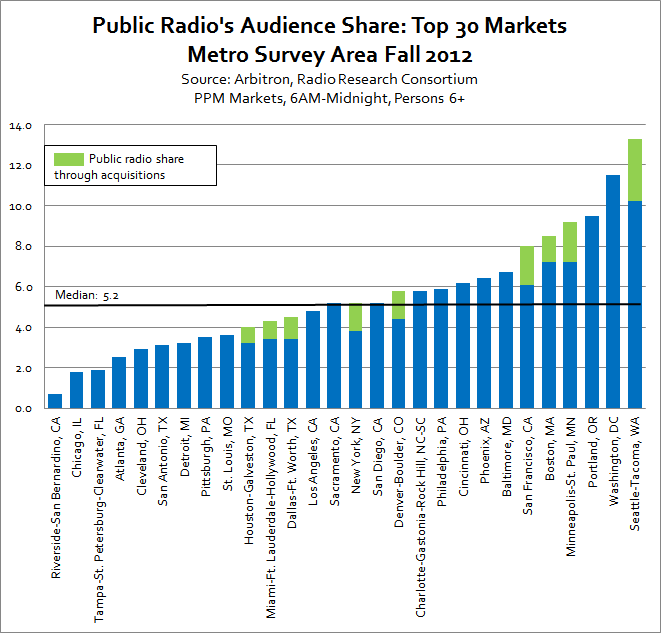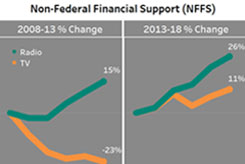A review of radio transactions in the top 30 markets indicate that existing operators in eight markets expanded services by acquiring new stations. PRC provided brokerage and consulting services for six* of these eight station acquisitions. In Seattle, KING FM switched from a commercial to a noncommercial classical format as well. The chart takes a snapshot of public radio’s audience share across the top 30 markets and highlights the audience growth for the following new 24/7 public radio services:
- Seattle-Tacoma, WA: In 2011 KING 98.1 FM transitioned from a commercial to a noncommercial classical service.
- Minneapolis-St. Paul, MN: In 2004 Minnesota Public Radio purchased KCMP 89.3 FM (prev. calls: WCAL) to provide a 24/7 Triple A service appealing to a younger audience.
- Boston, MA: In 2009 WGBH purchased WCRB 99.5 FM* to provide a 24/7 classical music service.
- San Francisco: In 2012 the University of Southern California purchased KDFC 89.9 FM, KOSC 90.3 FM, and KXSC 104.9 FM* to provide a 24/7 classical music service.
- Denver-Boulder, CO: In 2012 Colorado Public Radio (CPR) purchased KVOD 88.1 FM (prev. calls: KFDN)* to provide full-time news and full-time classical service on two separate FM stations.
- New York, NY: In 2009 New York Public Media purchased WQXR 105.9 FM to provide a 24/7 classical service.
- Dallas-Ft. Worth, TX: In 2009 North Texas Public Broadcasting purchased KKXT 91.7 FM (prev. calls: KVTT)* to provide a 24/7 Triple A music service.
- Miami-Ft. Lauderdale-Hollywood, FL: In 2008 American Public Media Group purchased WKCP 89.7 FM (prev. calls: WMCU)* to provide a 24/7 classical music service.
- Houston-Galveston, TX: In 2011 the University of Houston purchased KUHA 91.7 FM (prev. calls: KTRU)* to provide a 24/7 classical music service.
*PRC provided brokerage /consulting services.
Markets are ordered by their rankings, defined by Arbitron based upon population size. Chart includes Arbitron PPM subscribers only.
Several factors such as demographics, station inventory and competition contribute to differences in audience share between the markets.




